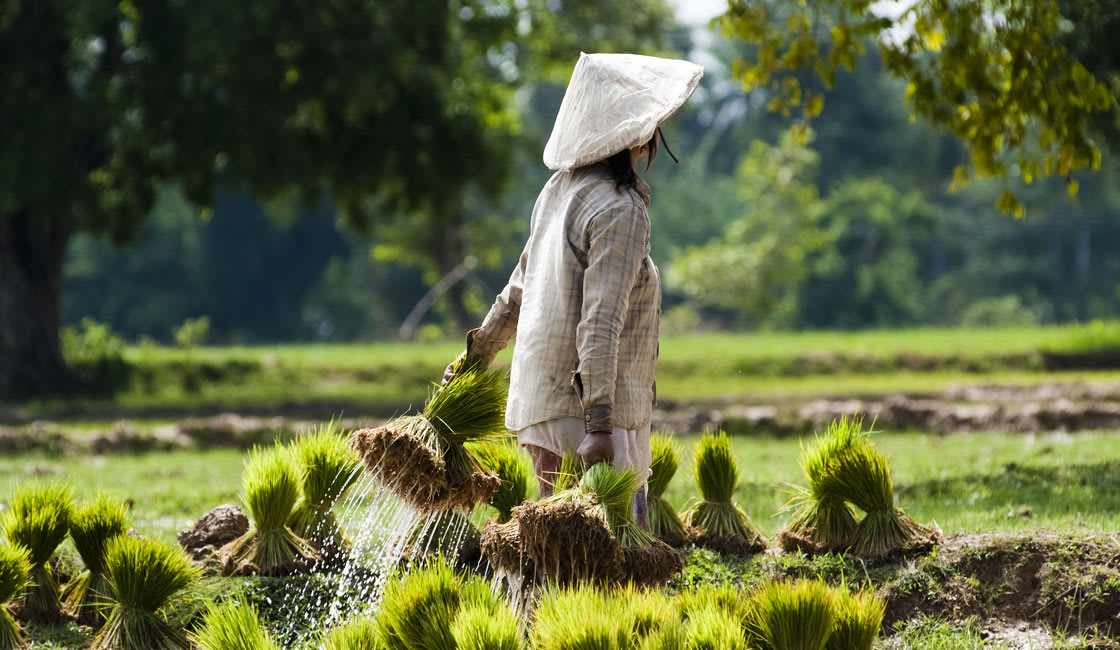
Traditional Laos food is vibrant, colorful, packed with herbs, chilies, and combinations of ingredients that will thrill your taste-buds.
The cuisine is simple, honest and earthy, making ample use of bitter flavors and relying much on the inclusion of fresh vegetables, herbs, chicken, duck, pork, beef and water buffalo, game from the jungle, and fish from the Mekong. Dishes will often incorporate thinly sliced banana flower, which adds bitterness and floral notes, while sliced raw eggplant, for example, lends bitterness as well as texture.
Other common ingredients are fresh bamboo shoots, ginger, galangal, and copious amounts of fresh herbs and spices including lemongrass, anything from the ginger-root family, mint, garlic, cilantro, makrut lime leaf, and dill. Lao people pride themselves on dabbling in the use of exotic wild greens, which are generally quite crisp and often harvested right before the meal is served.
Fish and prawns are readily available but, with Laos being a landlocked country, are nearly always of the freshwater variety. There is plenty of fresh fruit, especially in the Mekong Valley, and in the appropriate seasons, especially towards the end of the hot season in May, markets overflow with a wide variety of exotic fruits including mango, papaya, coconut, rambutan, durian, custard apple, guava, mangosteen, starfruit, pineapple, watermelon, jackfruit and bananas.

In the evenings, numerous vendors line the streets of Vientiane and Luang Prabang peddling the flavors of the country – bright-red curries served on beds of long-grain rice, grilled river-fish, freshwater prawns, homemade pork and herb sausages, French inspired baguettes filled with an array of ingredients such as tomatoes, cheese, pork meat and chili sauces, and ‘salads’ of local vegetables.
Soup is considered a necessary part of any Lao meal; look out for kaeng no may − fresh bamboo-shoot soup, kaeng het bot − made with a variety of fresh mushrooms, meat soups made with bitter gourd, or with galangal and coconut milk, and fish soups with fragrant herbs. Many of these dishes are almost identical to Thai dishes served on the other side of the Mekong. Charming cafes additionally serve pies, cookies, cakes, and an extensive selection of teas and good coffees grown in the hills of southern Laos.
French cuisine is abundant, chiefly because of the French colonial legacy. French bread is baked each day, and baguettes can often be seen in the shopping baskets of locals heading home from the market. Along with croissants, breadsticks are served for breakfast with pâté, fried eggs and omelets.
The staple sauce for Lao cuisine is known as paa daek, made from a highly pungent clay-pot-fermented fish paste. This condiment is eaten with just about everything at every meal, and is responsible for the very rich taste.
Lao Beer is the most famous brand of beer found in Laos, and widely considered to be the best tasting beer in the region. It is traditionally served with ice in small glasses, and enjoyed among friends and families. If you find yourself invited for a glass, be prepared to finish a few more bottles than you may expect. The local firewater, meanwhile, is a spirit called Lao-lao distilled from fermented glutinous sticky rice.
The drink has a long tradition and hails from rural Laos. Often wrongly labeled as Lao whiskey, the production of this clear spirit is unregulated, and there are many regional varieties that often significantly vary in flavor, color, and quality. Most examples are clear, colorless, and quite potent. Bottles containing snakes, insects, or scorpions are also available but are mainly sold as souvenirs. Lao-lao is still mainly produced as a home-brew, and it is traditionally served with meals.

Upcountry Lao cuisine is very definitely an acquired taste and may not be to your liking. Many people live near to forests where hunting and gathering of food remains a way of life. Jungle foods and game are therefore more in evidence in the north. Besides wild boar and deer, these include such unlikely animals as pangolin, monitor lizard, civet, wild dog and field rat. Raw meat is common, served with a salad of chopped jungle leaves and herbs, usually washed down with the fiery home-made rice spirit.
For the Laotians, sometimes the choicest parts are those pieces of the animal that are often discarded by Westerners. The intestine, the foot, the cartilage, and bone are considered to be the best bits. Oil is in short supply, so sautéed meat is not very common, but ground up meat mixed with egg and seasonings or spices, or larger cuts of grilled meats are more commonly seen in Lao cuisine. These meats are then topped with a variety of accompanying sauces.
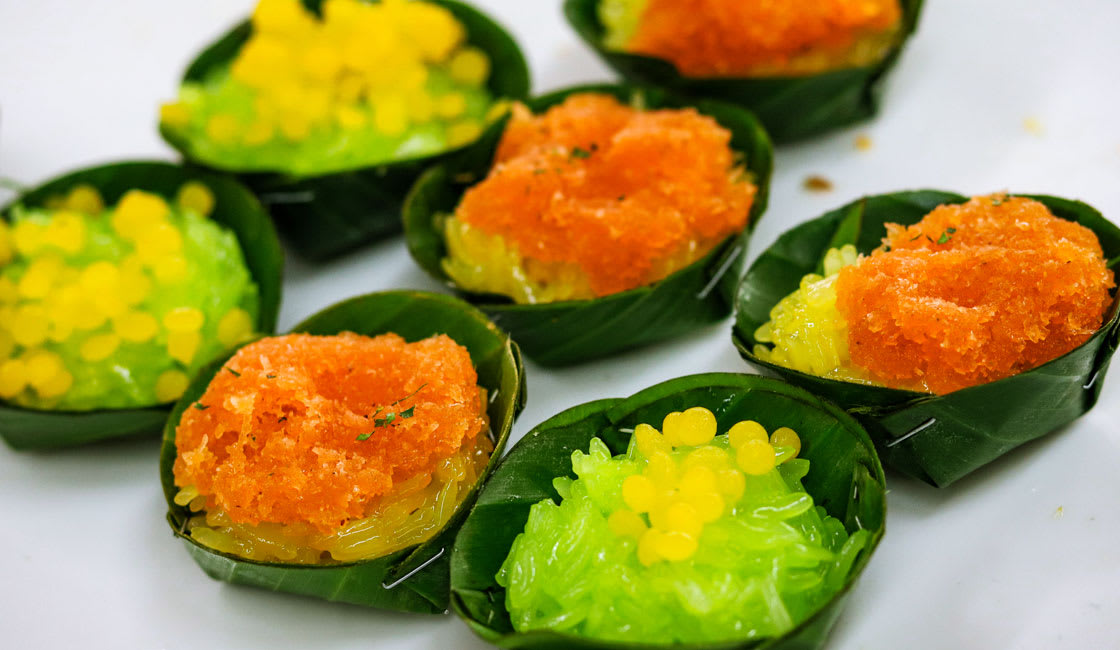
A staple traditional food among the Laotians is khao niaw or glutinous sticky rice, which is traditionally served in a woven bamboo basket before being deftly rolled into a neat, small ball and eaten with the hand. This is generally accompanied by a selection of dips, parboiled vegetables, salads, soups and various curried meat or fish dishes. The bamboo basket is called a tip khao.
Eating in Laos is a communal activity, where dishes are shared by all at the table, and it’s considered bad luck not to replace the lid on top of the tip khao at the end of the meal. When Laotians go off to work in the fields or elsewhere you will often see these small woven baskets hanging at their sides and filled with supplies of sticky rice and perhaps small amounts of fish or meat, which will serve as their midday meal. Khao niaw is so deeply embedded in the Lao culture that the people sometimes refer to themselves as the children or descendants of sticky rice.
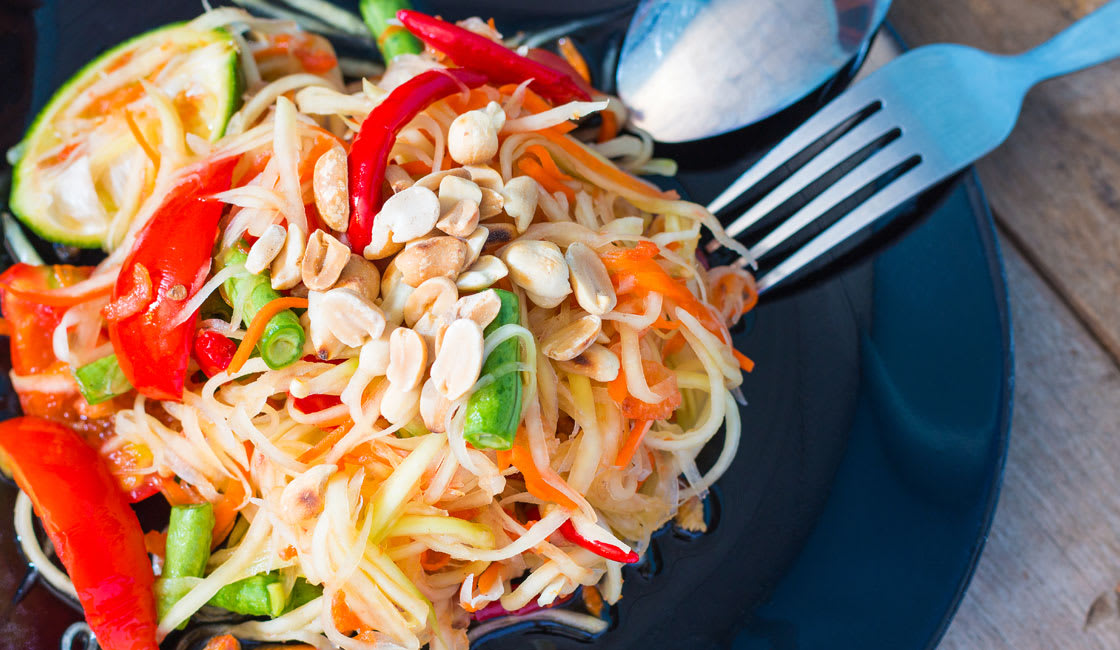
Tam som is a spicy green papaya salad, mixed with garlic, tomatoes, ground peanuts, crab, and fish sauce. The crunchy greens, chili and lime sauce, and crisp toppings make it a must-try. The varieties are plentiful and can include various additions. The sauce can also appear in many other combinations, and can significantly vary in sweetness and spiciness. Restaurants and street stalls will allow you to choose the variety you prefer and will adjust the ingredients in accordance with your preference.
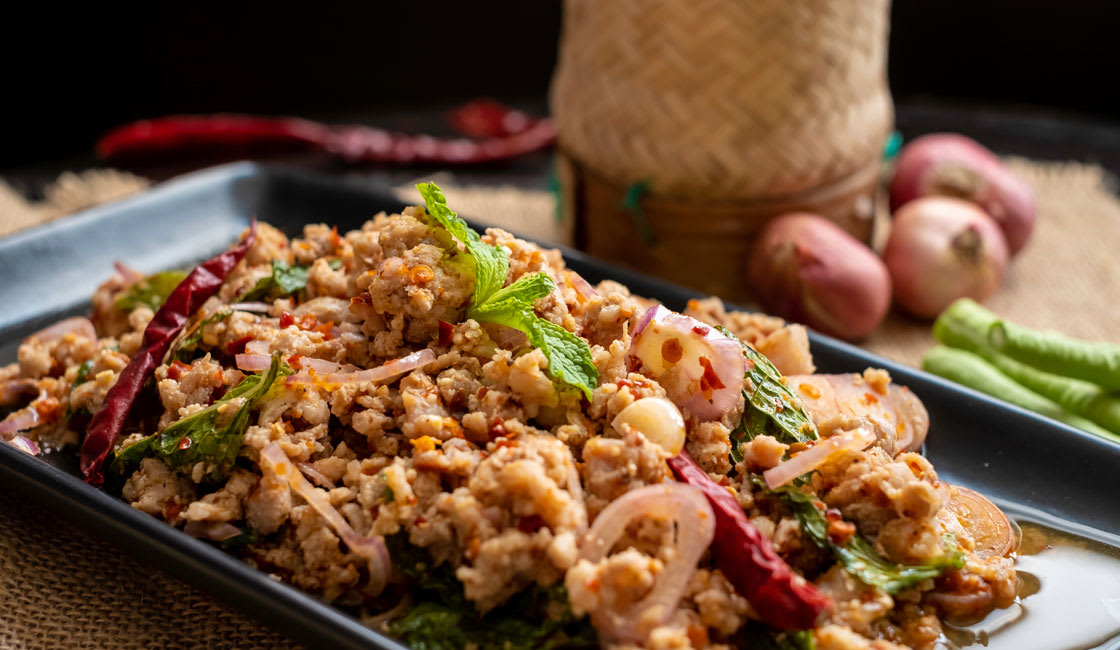
Another standby is larb, translated on most menus simply as a meat salad, and also commonly spelled in English as laap or lab. This is one of the ultimate staple Laos foods, and refers to any meat prepared immediately after butchering. Always fresh, often eaten raw, this dish is a mainstay in the Laos local diet. You can choose from any meat that the restaurant has available, but certain individual restaurants may specialize in pork laap, for example, or fish larb and often include the innards.
The chef will mince and then quickly fry − or keep raw if you order the raw version − the meat while adding fish sauce, a garden full of fresh herbs, including Laos mint, cilantro, garlic, chili, and green onions, lime juice, and toasted sticky rice powder, which is the ingredient that gives larb its signature flavor. All ingredients are mixed until everything is perfectly even. Local versions of Laos larb can also include bile, yes, digestive fluid, adding a unique bitterness to your plate.
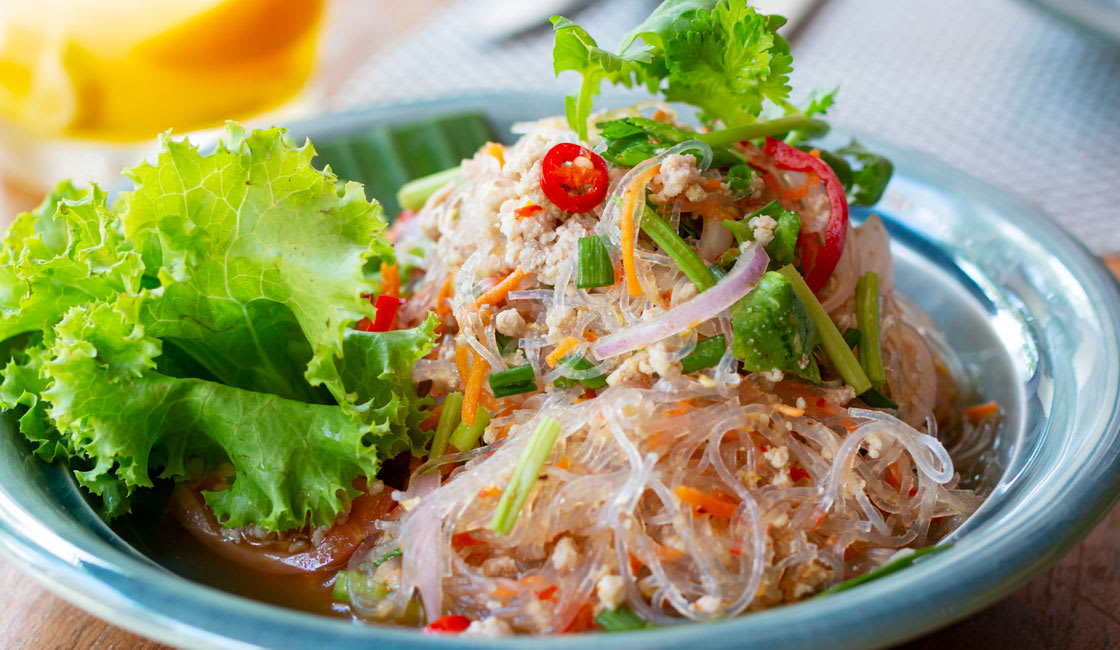
A great first meal of any full-day Laos food tour, this simple and satisfying bowl of rice noodles can be found on nearly every street corner in Laos. Hours in the making, it begins with a massively deep flavorful meat-stock. The chef is usually up long before dawn, creating a gigantic drum full of soup and wheeling it to the front door of a restaurant −look out for a line of people alongside a stainless-steel container.
Khao Piak Sen is unique among rice noodle dishes in that it is always made using thick, hand rolled noodles, which are blanched in the soup stock and therefore retain their starch, giving the soup an almost gravy like thickness – rather than a typical watery soup. At the table setting, you will usually find a small dish of fresh herbs, hot red peppers fried in oil, shrimp paste, and often some dried crushed peanuts as well.
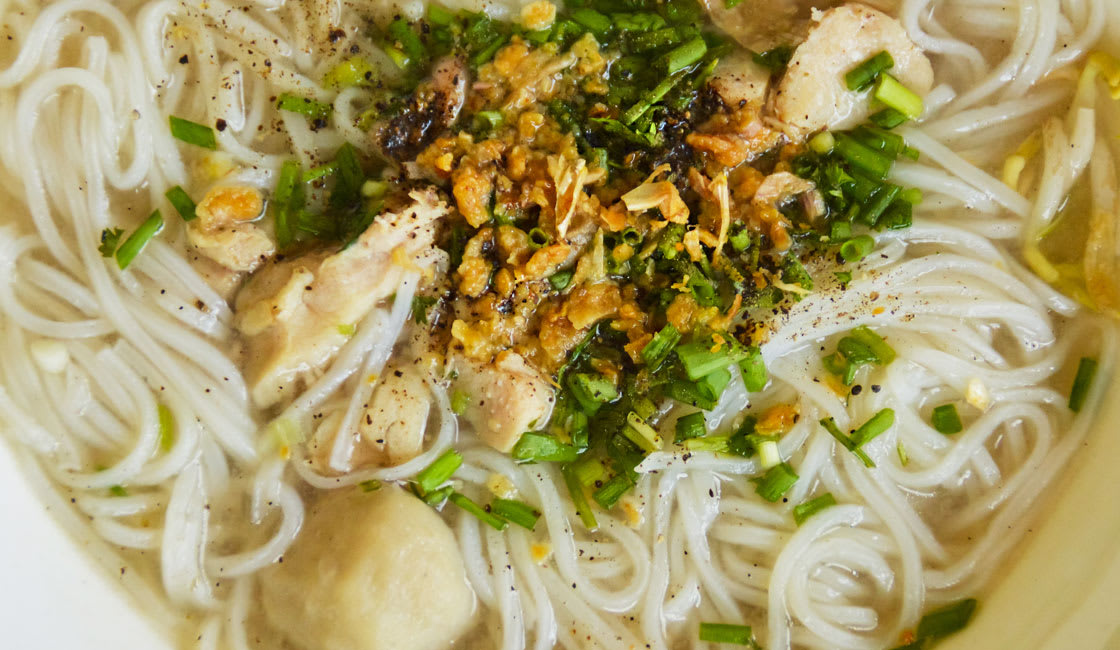
Then there is rice vermicelli, or khao poun. This is served cold with a variety of raw chopped vegetables, on top of which is placed a coconut-milk sauce flavored with meat and chilies. This is considered an auspicious dish at weddings and other celebrations, and is usually a favorite with foreigners.
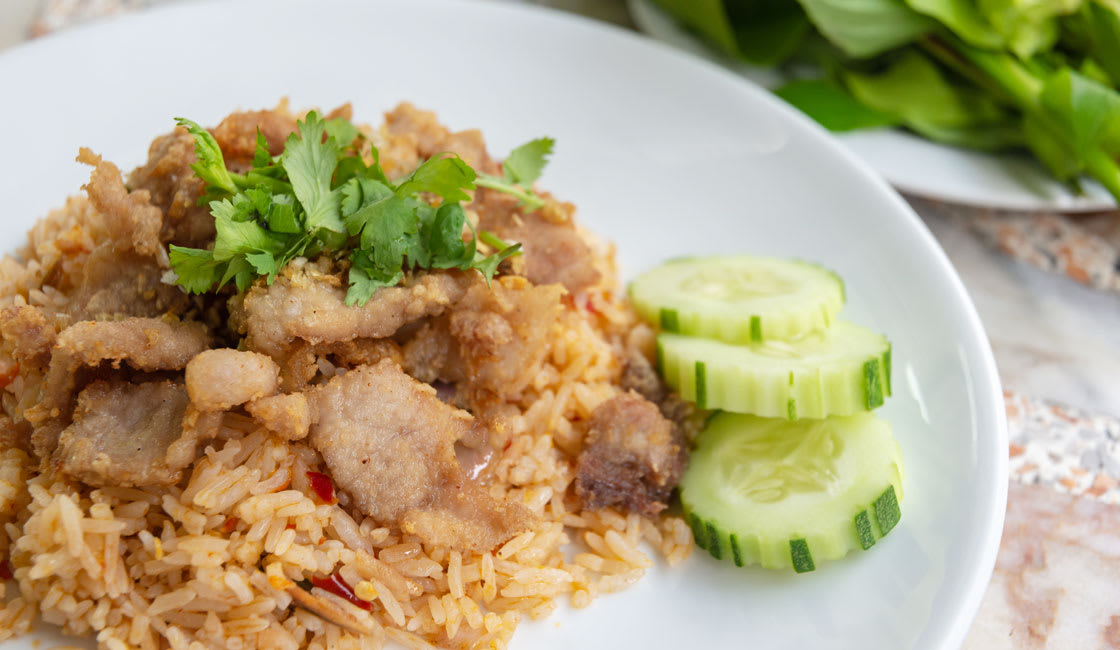
Nam Khao Tod is a fresh salad made with deep-fried rice balls, chunks of soured pork sausage, peanuts, grated coconut, fish sauce, dried chili peppers, and other ingredients. It is traditionally eaten as a wrap by filling the individual lettuce leaves with the nam khao mixture, topped with fresh herbs and dried chilis.
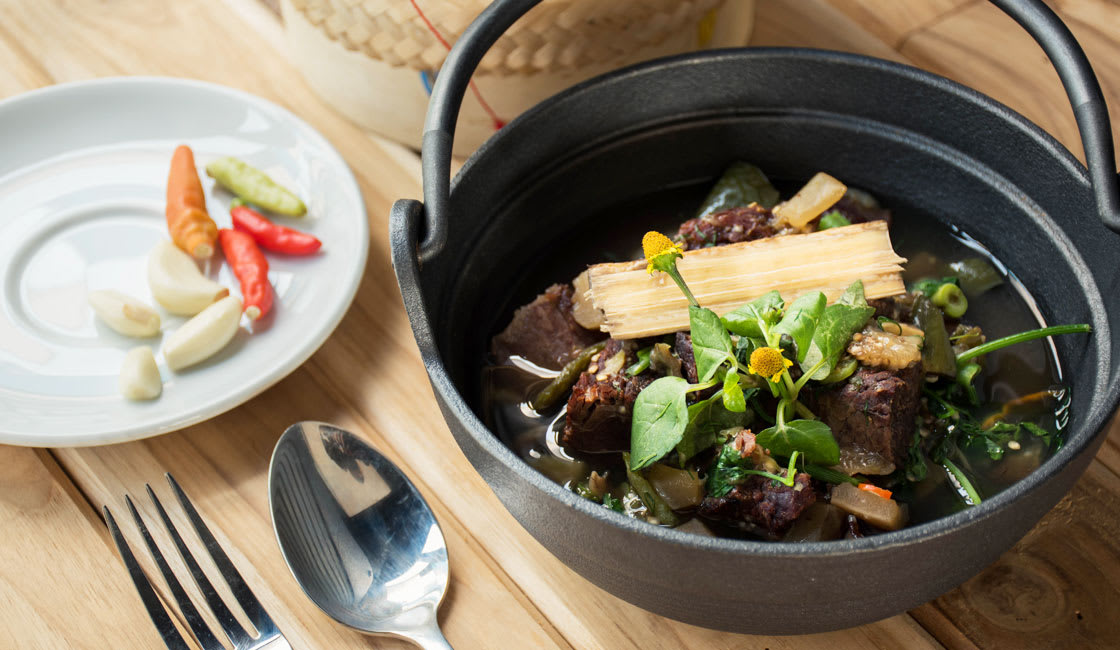
Lam is a popular regional dish from Luang Prabang. A mildly spicy, slightly tongue numbing, stew usually slow-cooked with lemongrass, dried buffalo meat and skin, game meat, quail or chicken, eggplants, wood ear mushrooms, and yard-long beans, served with paa daek and eaten with crisp-fried pork skin and sweet basil.
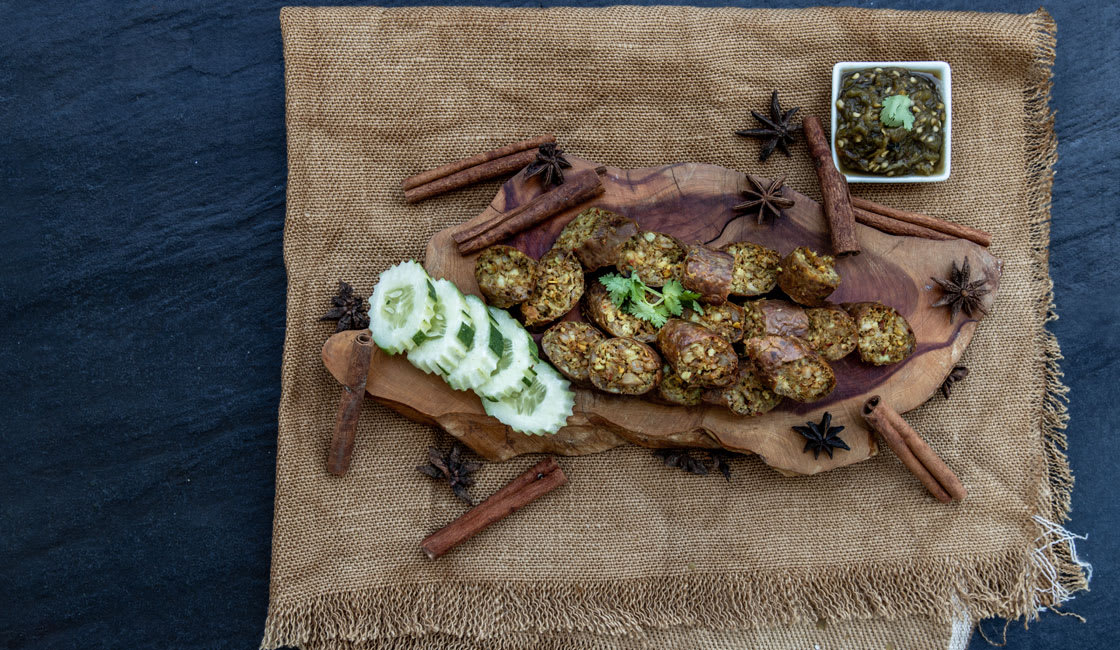
These herbaceous and slightly spicy Lao pork sausages are the perfect balance of firm, springy and juicy, complete with a smoky aroma. Using a mixture of pork belly, skin, and minced meat, ingredients can also include diced galangal, chopped green onions, lemongrass, kaffir lime leaves, cilantro and dill, with fresh chili peppers.
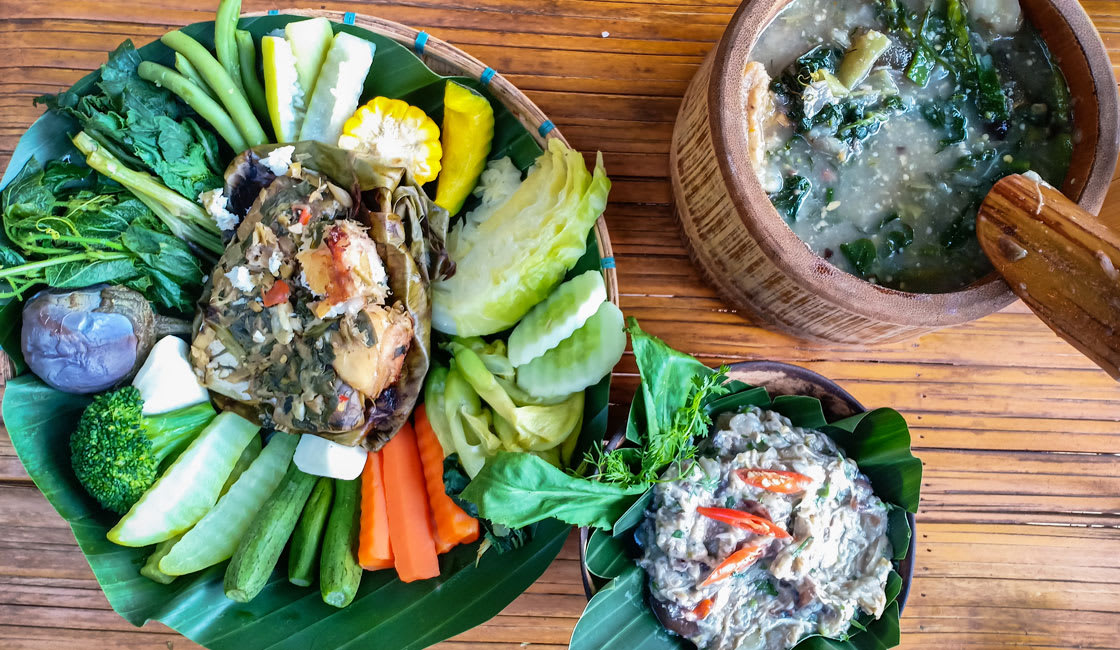
Mok Pa is steamed fish that is typically wrapped up in banana leaves, or taro leaves, and tied with bamboo string. It is prepared with lemongrass, kaffir leaves, green onions, fish sauce, green chilis, shrimp paste, and fresh dill. All these ingredients are mixed together with steamed fish. Mok Pa should never be served dry, and must be paired with sticky rice.
In Laos, food is the most important activity of the day, and it is quite common for people to greet each other by immediately asking, “Have you eaten food?” Additionally, Lao people take great passion in sharing traditional dishes with curious travelers. Enjoy!
While Rainforest Cruises aim to provide accurate and up-to-date information, we make no representations as to the accuracy or completeness of any information herein or found by following any link on this site. Rainforest Cruises cannot and will not accept responsibility for any omissions or inaccuracies, or for any consequences arising therefrom, including any losses, injuries, or damages resulting from the display or use of this information.




